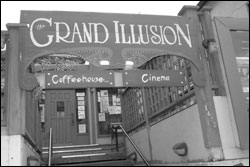The funeral won’t follow the wedding. True, the Grand Illusion on University Way will shutter this Friday, Feb. 27, after the run of Rana’s Wedding. But it will reopen in early April with its format largely unaltered. The theater has just been sold by its nonprofit owner, the Northwest Film Forum, to a new nonprofit consortium led by Guerren Marter, himself a longtime member/employee of the NWFF. It’s the second time the theater has changed hands in the last eight years. The NWFF bought it in December 1996, when there wasn’t much of a market for an anachronistic, hole-in-the-wall art cinema with a smaller screen and more modest sound system than many basement home-entertainment centers. As NWFF Executive Director Michael Seiwerath remembers, “There weren’t really any other buyers.”
Nor would there be today. “The Grand Illusion wouldn’t fare well on the open market,” says Seiwerath of prospective purchasers. In a friendly, extended-family transaction, the NWFF sold the cinema for roughly $26,000—basically what it paid eight years ago, instead of gutting the place for its seats, projectors, etc. “It is a bit of a sweetheart deal” says Seiwerath. “It allows [the buyers] to get on their feet and run it.”
So why is the NWFF shedding its biggest and most visible venue? It’s all part of a grand scheme to consolidate operations on Capitol Hill. NWFF also plans to close the Little Theatre when its current programming calendar expires on April 18. Then, possibly as soon as May, NWFF will open a new master space at a more central location, on 12th Ave-nue (near Pike Street), which will house two theaters along with administrative, editing, and filmmaking facilities.
A former dentist’s office, converted to a cinema in 1970 by impresario Randy Finley, the Grand Illusion is one of the oldest and most beloved surviving institutions on the Ave—a flagship not just for the NWFF, but an icon for all Seattle cinephiles. Named for the Jean Renoir classic, the theater would surely be doomed without the support of the NWFF or an equivalent nonprofit (as Seiwerath acknowledges). Says Marter, “I was a bit shocked that they would sell. I heard a rumor about a sale [and thought], ‘Man, that’s such a bad idea.'” For the tiny landmark to survive, he realized, he’d have to start raising money fast—including from his own pockets and family investors.
He continues, “We’re just trying to preserve the status that the theater has now. We’re not going to do much differently.” Among his four other board members involved in running the reborn Grand Illusion will be Spenser Hoyt, another NWFF veteran who’s also worked alongside Marter at Scarecrow Video. (Additional 16mm and video projectors are anticipated to add flexibility to the venue.)
THE GRAND ILLUSION’s niche has always been somewhat precarious, and the management shift raises the persistent question of how hospitable the U District is toward repertory-oriented and art-film pro-gramming. Conditions were quite different when Finley began building the chain that would become the Seven Gables (now Landmark) circuit—boomers were flocking to campus film societies; there was no home video or cable; Godard and Truffaut were exciting and new. Thirty-four years later, the Ave is something of a commercial wasteland, overrun by street kids and panhandlers, afflicted by broken-tooth storefronts and landlords basically waiting for the area to be rezoned. Meanwhile, Landmark’s nearby Varsity Theater has a competing rep screen—and deeper pockets. Another problem facing the Grand Illusion—how to reach all those college kids weaned on Nintendo, DVD, and reality TV? Does the nouvelle vague mean anything to them? Should it?
Marter and Hoyt haven’t yet made any programming decisions, but Marter vows to avoid fare that tends to the “stiff” or too-arty end of the spectrum—as the NWFF could be accused of in some instances. (The Impure Glance, anyone?) Given the cost of print rentals, Marter explains, the theater will generally continue with a one-film-per-week format, director tributes, and wacky late-night weekenders so beloved by Hoyt. Kid-friendly weekend matinees may be reintroduced, along with more UW tie-ins and lectures. Memberships will also be sold (like the NWFF), and Marter expects to offer student discounts. “The university is key to us,” he adds. “I definitely think it’s a different market [than Capitol Hill]. We want to reach out to those students.”
Can an Adam Sandler retrospective be far behind? Here’s my free marketing tip: costume night for The Wedding Singer.








